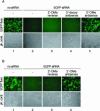Sequence-specific inhibition of microRNA- and siRNA-induced RNA silencing
- PMID: 14970398
- PMCID: PMC1370948
- DOI: 10.1261/rna.5235104
Sequence-specific inhibition of microRNA- and siRNA-induced RNA silencing
Abstract
A large number of miRNAs have recently been discovered in plants and animals. Development of reverse genetic approaches that act to inhibit microRNA function would facilitate the study of this new class of noncoding RNA. Here we show that 2'-O-methyl oligoribonucleotides, but not 2'-deoxyoligonucleotides specifically inactivate the RNAi activity associated with miRNA-protein complexes in human cell extracts as well as in cultured human cells.
Figures



Similar articles
-
siRNAs can function as miRNAs.Genes Dev. 2003 Feb 15;17(4):438-42. doi: 10.1101/gad.1064703. Genes Dev. 2003. PMID: 12600936 Free PMC article.
-
[Great potential of small RNAs: RNA interference and microRNA].Rev Invest Clin. 2006 Jul-Aug;58(4):335-49. Rev Invest Clin. 2006. PMID: 17146945 Review. Spanish.
-
A small molecule enhances RNA interference and promotes microRNA processing.Nat Biotechnol. 2008 Aug;26(8):933-40. doi: 10.1038/nbt.1481. Epub 2008 Jul 20. Nat Biotechnol. 2008. PMID: 18641635 Free PMC article.
-
Discovery, biology and therapeutic potential of RNA interference, microRNA and antagomirs.Pharmacol Ther. 2008 Jan;117(1):94-104. doi: 10.1016/j.pharmthera.2007.08.004. Epub 2007 Sep 7. Pharmacol Ther. 2008. PMID: 17928059 Review.
-
Translation repression in human cells by microRNA-induced gene silencing requires RCK/p54.PLoS Biol. 2006 Jul;4(7):e210. doi: 10.1371/journal.pbio.0040210. PLoS Biol. 2006. PMID: 16756390 Free PMC article.
Cited by
-
Shedding Light on the Molecular Diversities of miRNA in Cancer- an Exquisite Mini Review.Mol Biotechnol. 2024 Nov 4. doi: 10.1007/s12033-024-01312-5. Online ahead of print. Mol Biotechnol. 2024. PMID: 39496855 Review.
-
Short 2'-O-methyl/LNA oligomers as highly-selective inhibitors of miRNA production in vitro and in vivo.Nucleic Acids Res. 2024 Jun 10;52(10):5804-5824. doi: 10.1093/nar/gkae284. Nucleic Acids Res. 2024. PMID: 38676942 Free PMC article.
-
Oligonucleotide therapies for nonalcoholic steatohepatitis.Mol Ther Nucleic Acids. 2024 Mar 30;35(2):102184. doi: 10.1016/j.omtn.2024.102184. eCollection 2024 Jun 11. Mol Ther Nucleic Acids. 2024. PMID: 38665220 Free PMC article. Review.
-
miRNA-Based Technologies in Cancer Therapy.J Pers Med. 2023 Nov 9;13(11):1586. doi: 10.3390/jpm13111586. J Pers Med. 2023. PMID: 38003902 Free PMC article. Review.
-
Inhibition of miR-200b-3p confers broad-spectrum resistance to viral infection by targeting TBK1.mBio. 2023 Aug 31;14(4):e0086723. doi: 10.1128/mbio.00867-23. Epub 2023 May 24. mBio. 2023. PMID: 37222520 Free PMC article.
References
-
- Abrahante, J.E., Daul, A.L., Li, M., Volk, M.L., Tennessen, J.M., Miller, E.A., and Rougvie, A.E. 2003. The Caenorhabditis elegans hunchback-like gene lin-57/hbl-1 controls developmental time and is regulated by microRNAs. Dev. Cell 4: 625–637. - PubMed
-
- Ambros, V. 2003. MicroRNA pathways in flies and worms: Growth, death, fat, stress, and timing. Cell 113: 673–676. - PubMed
-
- Ambros, V., Lee, R.C., Lavanway, A., Williams, P.T., and Jewell, D. 2003. MicroRNAs and other tiny endogenous RNAs in C. elegans. Curr. Biol. 13: 807–818. - PubMed
-
- Aravin, A.A., Lagos-Quintana, M., Yalcin, A., Zavolan, M., Marks, D., Snyder, B., Gaasterland, T., Meyer, J., and Tuschl, T. 2003. The small RNA profile during Drosophila melanogaster development. Dev. Cell 5: 337–350. - PubMed
Publication types
MeSH terms
Substances
Grants and funding
LinkOut - more resources
Full Text Sources
Other Literature Sources
Research Materials

